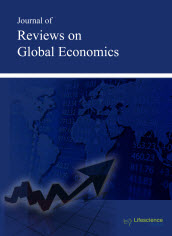jrge
Abstract - Corporate Lending in Overdraft Mode: Determination of Limit and Criteria for Economic Justification
|
|
Abstract: For a lending institution, overdrafts to corporate customers are attractive in terms of maintaining bank liquidity and increasing revenues from operating activities. The introduction of this credit service and expansion of its application does not require additional capital investments from the bank, but at the same time enhances its competitive position, since this service can not be provided by non-bank financial services operators, but exclusively by banks, because they act as financial intermediaries and settlement centers. When lending in overdraft mode, the bank has two specific tasks - determining the overdraft limit and assessing the economic soundness of lending in this mode. The problem of the current moment is that the lending banks solve these tasks, based on the administrative approach, often subjective, which does not have a unified economic justification, characterized by the length of the decision-making process for the loan application. This problem does not allow the bank to "put on stream" making decisions on lending in overdraft mode and thus, to give this service speed and mass character. As a solution to this problem, the article proposes a unified methodology for determining the limit and criteria for the correspondence of the corporate client's cash flow to the overdraft regime, which allows the bank to standardize the decision-making process for applications for lending in the form of an overdraft. Keywords: Overdraft, overdraft mode, determination of limit, economic justification, corporate lending, overdraft criteria. |
Abstract - Central Bank Policy and Cryptocurrencies
|
|
Abstract: Private cryptocurrencies became an integral part of the financial market. Central banks expressed various positions with respect to cryptocurrency from strong denial to non-intervention. We found out a common and dominating trend in the central bank’s policy to lead the further development of crypto-currency by restrictions, robust surveillance and licensing. The first section contains common information about central banks’s approach to regulation cryprocurrencies. Next section summarizes the treatment of cryptocurrency by central bankers, also it cointains 2 tables devoted to typology of cryptocurrency legality by countries and recognition of cryptocurrency by countries. Section 3 is devoted to the impact of global crisis on the dissemination of digital cryptocurrencies and contains 5 tables with information about banknotes and coins in circulation and a tables with top-10 cryptocurrencies. Section 4 describes the typology of warning signals sent by central banks to general public, investors, and market players. Section 5 concludes the material. Keywords: Currency, Money, Central Bank, Monetary Policy, Cryptocurrency. |
Abstract - The Concept of Fair Pricing in the Regulation Framework of the Russian Securities Market
|
|
Abstract: High risks and volatility in the stock market of Russia hinder the transformation of savings into investments and increase the speculative nature of transactions. Russian business does not use the securities market mechanism of financing investments widely enough. One of the causes of this is the faults in the model of securities market regulation in Russia and the legislative gaps. The aim of this article is developing suggestions concerning the improvement of government regulatory practice and self-regulation in securities market in Russia. The study is based on the methods of institutional, comparative and graphic analysis. Solving the problems connected with the set aim, the authors were the first to suggest the analysis of the relationship between the ability of the Russian capital markets to implement its allocative functions on the basis of fair pricing and the efficiency of the capital markets regulatory system. A relationship has been revealed between the speculative character of the Russian securities market and the faults in the model of its regulation. Suggestions have been grounded on the improvement of the existing rules and regulation in the Russian securities market, working out the foundations of long-term public policy for securities market regulation. Keywords: Fair pricing, financial market regulation, volatility overflow, insider information, stock price manipulation. |
Abstract - Optimal Carry Trade Strategy Based on Currencies of Energy and Developed Economies
|
|
Abstract: Optimal investment strategy depends on the loan in currencies of developed economies (EUR, JPY) and lending in currency of energy economies (RUB, BRL). Since 2014, there has been a shift to euro funding as the currency of financing for carry trade against the backdrop of the European Central Bank (ECB) not changing the volume of incentives to accelerate economic growth. There is some evidence to support the use of euro as a funding currency for carry trade, such as the irrational behavior of the currency during the Greek shock in the middle of 2015. Thus, the impact of yen-based trading strategies on the Japanese stock market is unconventional. It also became evident that the relationship between the dynamics of US dollar and S&P 500 index is extremely uncertain. When risk appetite waned due to the high volatility, the money was back. The ECB's zero-rate monetary policy has some impact on the global stock market. Keywords: Carry trade, Uncovered interest parity, CRB industrial return, Monetary policy, Optimal parametric portfolio. |






















